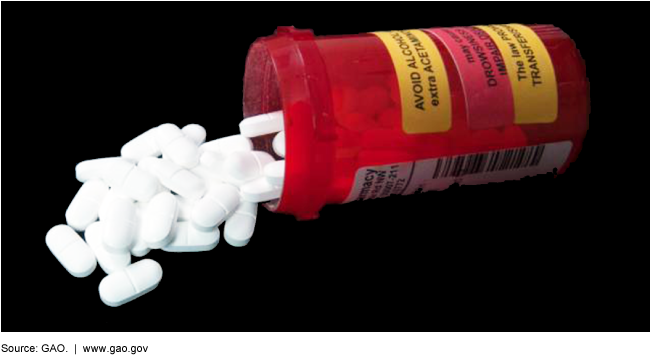Prescription Opioids: Medicare Needs Better Information to Reduce the Risk of Harm to Beneficiaries
Fast Facts
What can Medicare do to help address the nation's opioid crisis?
We've previously found problems such as "doctor shopping" and questionable prescribing practices in Medicare's prescription drug benefits. 14.4 million people were prescribed at least one opioid through Medicare in 2016. While many opioids prescribed addressed legitimate need, others may have been overprescribed.
This testimony revisits our analysis of Medicare's efforts to reduce inappropriate opioid prescribing. We suggested ways to help Medicare collect information on doctor investigations and at-risk beneficiaries that could help it determine whether its efforts are working.

Photo of pills spilling out of a prescription drug bottle.
Highlights
What GAO Found
In October 2017, GAO found that the Centers for Medicare & Medicaid Services (CMS) provided guidance on the monitoring of Medicare beneficiaries who received opioid prescriptions to plan sponsors—private organizations that implement the Medicare drug benefit, Part D—but it lacked information on most beneficiaries at risk of harm from opioid use. Specifically, GAO found that
CMS provided guidance to plan sponsors on how they should monitor opioid overutilization among Medicare Part D beneficiaries, and required them to implement drug utilization review systems that use criteria similar to CMS's. Prior to 2018, the agency's criteria focused on beneficiaries who did all the following: (1) received prescriptions of high doses of opioids, (2) received prescriptions from four or more providers, and (3) filled prescriptions at four or more pharmacies. According to CMS, this approach focused actions on beneficiaries the agency determined to have the highest risk of harm. For 2018, CMS revised the criteria to include more at-risk beneficiaries.
CMS's criteria, including recent revisions, did not provide sufficient information about the larger population of potentially at-risk beneficiaries. CMS estimated that, in 2015, 727,016 beneficiaries would have received high doses of opioids regardless of the number of providers or pharmacies, but only 33,223 would have met its revised criteria. In 2016, CMS began to collect information on some of these beneficiaries using a higher dosage threshold for opioid use. However, based on Centers for Disease Control and Prevention guidelines, CMS's approach also missed some who could be at risk of harm. As a result, CMS had limited information to assess progress against the goals of the Medicare and Medicaid programs' Opioid Misuse Strategy, which includes activities to reduce risk of harm to beneficiaries.
CMS Estimates of 2015 Part D Beneficiaries with High Opioid Doses and Those Who Would Have Met Revised Overutilization Monitoring Criteria

CMS provided oversight on prescribing of drugs at high risk of abuse through a variety of projects, but did not analyze data specifically on opioids. According to CMS officials, CMS and plan sponsors identified providers who prescribed large amounts of drugs with a high risk of abuse, and those suspected of fraud or abuse may be referred to law enforcement. However, GAO found that CMS did not identify providers who may be inappropriately prescribing large amounts of opioids separately from other drugs, and did not require plan sponsors to report actions they take when they identified such providers. As a result, CMS lacked information that it could use to assess how opioid prescribing patterns are changing over time, and whether its efforts to reduce harm are effective.
Why GAO Did This Study
Misuse of prescription opioids can lead to overdose and death. Medicare and Medicaid, two of the nation's largest health care programs, provide prescription drug coverage that can include opioids. GAO and others have reported on inappropriate activities and risks associated with these prescriptions.
This statement is based on GAO's October 2017 report (GAO-18-15) and discusses (1) CMS oversight of Medicare beneficiaries who receive opioid prescriptions under Part D, and (2) CMS oversight of providers who prescribe opioids to Medicare Part D beneficiaries. For the October 2017 report, GAO reviewed CMS opioid utilization and prescriber data, CMS guidance for plan sponsors, and CMS's strategy to prevent opioid misuse. GAO also interviewed CMS officials, the six largest Part D plan sponsors, and 12 national associations selected to represent insurance plans, pharmacy benefit managers, physicians, patients, and regulatory and law enforcement authorities.
Recommendations
In the October 2017 report, GAO made three recommendations that CMS (1) gather information on the full number of at-risk beneficiaries receiving high doses of opioids, (2) identify providers who prescribe high amounts of opioids, and (3) require plan sponsors to report to CMS on actions related to providers who inappropriately prescribe opioids. HHS concurred with the first two recommendations, but not with the third. GAO continues to believe the recommendation is valid, as discussed in the report and in this statement.
